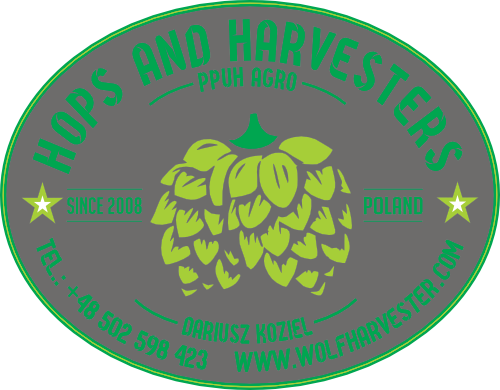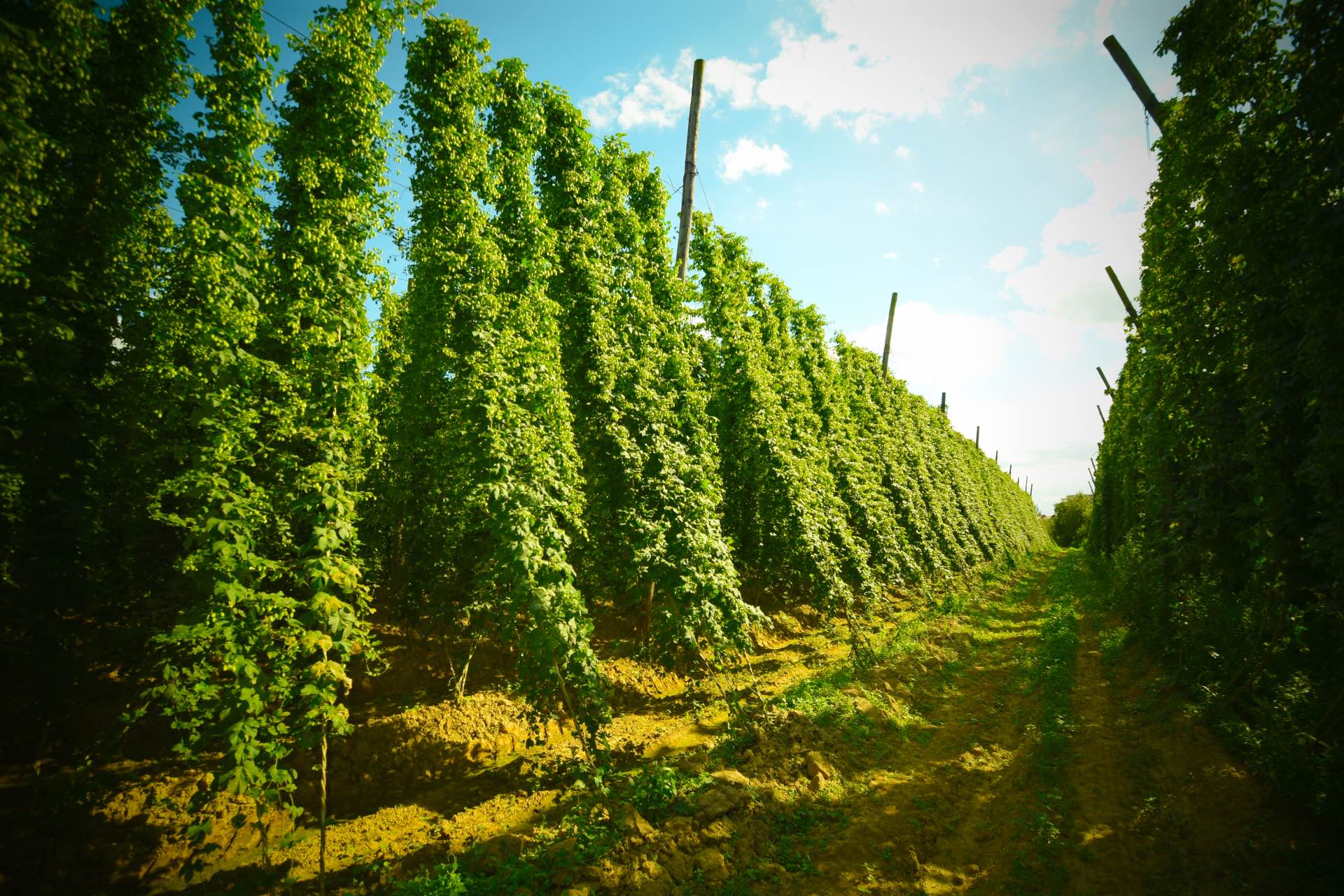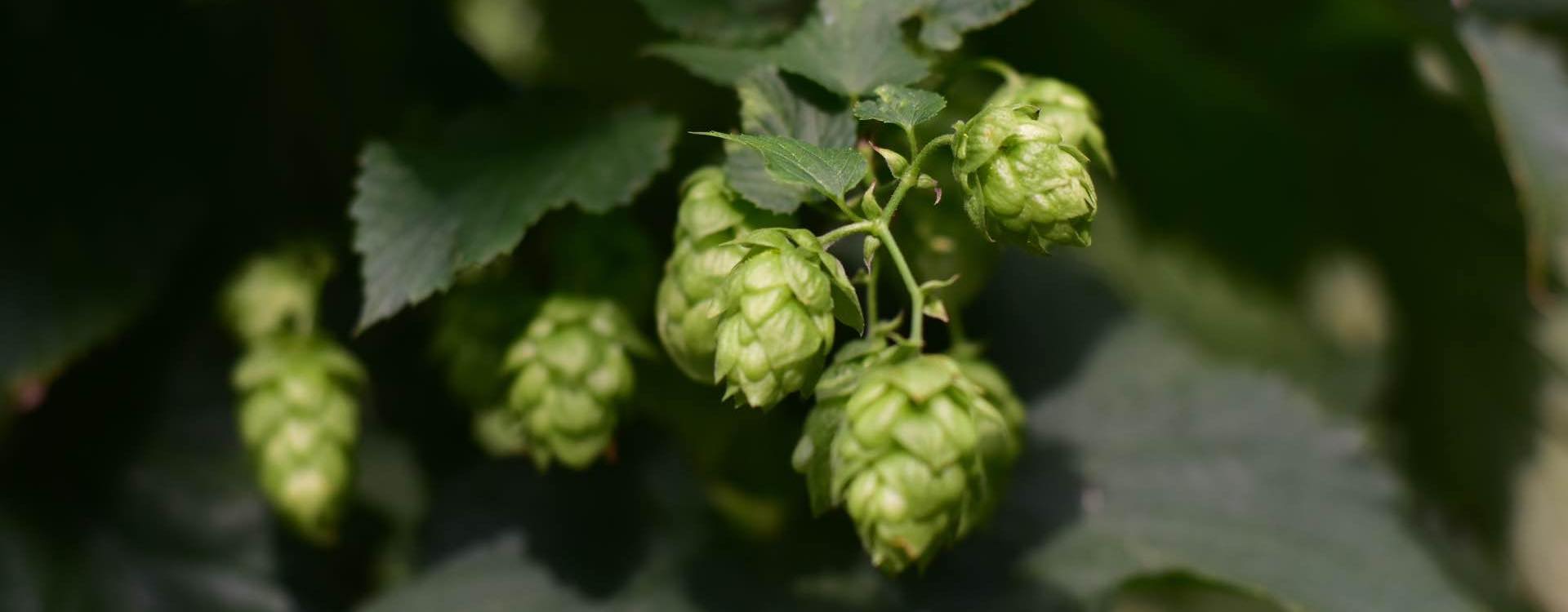
About Us
We are a small family company, active on the market since 2008.
Our seat is in the largest Polish hop region – the Lubelskie Province in the Wilków commune, situated in the very heart of a picturesque Vistula River Valley. The local microclimate gives hop produced in this area an extraordinary aroma and properties unseen elsewhere. We are active in the hop trade throughout the whole European Union.
We cooperate with the best hop planters to whom we put forth very rigorous requirements related to the process of production for the raw material to be of very high quality, have necessary certificates and that it could be used without problems not only in the brewery trade, but also the whole food and pharmaceutical industry. Due to very fruitful cooperation with recipients of a global range, who very dynamically operate in the hop trade, our hop is available in many countries.
Our policy of quality and hop contracting results in the fact that our customers are given constant and easy access to the raw material of the highest quality. Based on many years of loyal cooperation with our strategic trade partner, we actively participate in an international programme, whose aim is seeking and development of new varieties of hop.
Simultaneously, we deal with international trade and servicing of machines and devices for hop production, therefore we have a very well-developed network of international contacts in the group of planters from around the world. This means that we are not a typical entity participating in trade in hop, but one of the few who take care of not only the high quality of the produced raw material, but also for good the technical condition of machines and equipment used in this specialized field of agriculture.
Today, we cooperate with numerous entities of different sizes from many countries, operating in the hop industry, for which hop is an important production element.
Offer
Hop is packed in bags of type RB 60, which can contain from 60 to 65 kg of hop cones.
The second package type offered by us are specialized 1-kilogram bags made in the barrier foil technology. | Using this kind of package, hop is packed in negative pressure in industrial vacuum packing machines. As a result, the raw material packed in this way stays fresh for a long time, and it is easy for transportation.
For customers who want to store the raw material in their warehouses, we offer extended vacuum- packing variant b the option of packing in neutral gas – nitrogen. It gives an additional guarantee that the raw material protected in this way can be stored for a very long time without the risk of loss of its parameters.
Quality policy
Additionally, based on cooperation with external laboratories, we control the raw material as to humidity and the content of α – acids.
For storage and transport, we use specialized bags of RB60 type that guarantee no impact of external factors during storage.
The raw material is stored in warehouses specially adapted for this purpose, with walls made of thermally insulating sandwich panel, and the floor is made of industrial floors with resistance to water and other liquids and smooth surface allowing easy maintenance of cleanliness.
Warehouses are also subject to protection and control within the scope of DDD (deratisation, disinsection, disinfection) conducted by a specialized external company with experience and rights in this respect.
All these steps are intended to provide our customers with the raw material of high quality and safety of its use in any kind of production.
Caring about the premium quality of our raw material, we conduct direct supervision at every stage of production of hop and we care to make sure that this kind of production is based on good agricultural practices. Caring for production in compliance with GAP and GACP we conduct consulting, training in this respect, and we help to planters keep the documentation. All manufacturers with whom we cooperate are obliged to use only those plant pesticides that are approved for use in cultivation of hop and in doses not exceeding the recommended standards.
Each planter has its own control card, in which the date and the scope of the conducted control are recorded.
In order to confirm the quality of hop and for the raw material to be approved into trade, representative samples are taken from each planter, from each variety of hop, for each batch, and then they reach the WIJHARS laboratory. There, under the supervision of experts and using laboratory equipment, commercial quality is assessed. On the condition of fulfilment of criteria specified by the regulations, a certificate confirming the quality of the raw material is issued.

Program for development of new varieties
Thanks to joint trust and loyal cooperation, for several years we have been a participant of an important programme of international range conducted by Charles Faram & Co. Ltd.
The purpose of this project is to face the trends of the brewery market which requires new innovative varieties of hops with unique properties thanks to which brewers can brew beer with unique flavour and nature.

Thanks to the works of botanists, we received seedlings of new crossings of hop which were then sent to plantations located in different parts of our province and on soils of different classes to be able to specify optimum conditions in which plants will feel best, and the obtained cones will have unique properties. This is supposed to help to find and assess the usefulness of the variety in the perspective of its future in the brewery industry.
The initiative, in the case of success, has a potential to significantly and positively affect the whole hop and brewery industry.
Varieties of hops

The information comes from the book entitled
“Polskie odmiany chmielu”
[Polish hop varieties]”
by Urszula Skomra, PhD
Institute of Soil Science
and Cultivation
State Research Institute
Puławy 2010
We are working on reactivation of forgotten Polish varieties which, despite their excellent and exceptional properties, were thwarted by aggressive competition of the largest companies controlling the world hop market.
Using the arising occasion the beer revolution gives us, we want to show that our varieties are as good as those imported from other countries of the world at significantly higher prices, which are not always reasonable. In this way, we will face the trends of the market, presenting the offer addressed to those who want to distinguish themselves on the beer market with unique taste and aroma of produced beers achieved using the Polish unique varieties of hop.
Here is a review of varieties of hops from Polish plantations offered by us:
Cascade
Chinook
Like Cascade, it is ideal for beers of surface fermentation, in particular beers of IPA, APA type. Owing to its intensive aroma, it is also used for cold hopping.
Beside the Cascade variety, it is one of the most often used varieties by brewers in the US during full-scale been revolution on the local market.
Puławski
Marynka
Variety: gentian, with pleasant aroma (dual purpose)
Origin: Grown by means of crossing the Brewers Gold variety with wild male hop originating from former Yugoslavia
Year of registration: 1988
Plant – Delicate, not very lush, cylindrical or cigar shape, green stem. Leaves density small, leave surface smooth, leaves predominantly five-flap, aquamarine-green. Side shoots of average length, the first yield-bearing shoots placed low, approximately 60cm from the soil surface. Cones quite numerous, evenly located on the plant. In the initial period of vegetation, growth of the plant is slow. It requires systematic removal of runners and numerous shoots growing from the stump throughout the whole vegetation season. The plants are characterized by good capacity to guide to the guides and very good suitability for machine harvesting.
Cones – Bright green, mid-size (length approximately 3cm), egg-shaped, slightly pointy. Leaves adjacent, very closely laid on the rachis. Delicate, regular rachis.
Aroma – Hop with light floral note, pleasant, intensive.
Lubelski
Variety: superaromatic
Origin: Grown by means of individual-genealogical selection from the national population.
Year of registration: 1964
Plant – Lush, club shape, red-green stem. Leaves density average, in spring young yellow-green leaves. Side shoots long, brittle. The first yield-bearing shoots placed high, over 100cm from the soil surface. Numerous cones, in particular in the upper part of the plant. The plants are characterized by average capacity to guide to the guides and average suitability for machine harvesting.
Cones – Yellow-green, mid-size (length approximately 3cm), elongated, slightly flattened. Leaves slightly drawn apart, loosely laid on the rachis. Rachis very delicate, quite regular.
Aroma – High-quality hop, delicate, very pleasant.
Sybilla
Variety: aromatic
Origin: Grown by means of crossing the Lubelski variety with wild male hop originating from former Yugoslavia
Year of registration: 1996, in the period 2004-2006 Sybilla hop was freed from viruses and latent viroid of hop
Plant – Strongly growing, very lush, regular, cylindrical shape, green-red stem with clear stripes. Leaves density average, leave surface smooth. Side shoots long, unbreakable, the first yield-bearing shoots placed quite low, approximately 70cm from the soil surface. Numerous cones, evenly located on the plant. The plants are characterized by good capacity to guide to the guides and very good suitability for machine harvesting.
Cones – bright green, large (length approximately 4cm), elongated, slightly pointy. Leaves adjacent, closely laid on the rachis. Delicate, regular rachis.
Aroma – Pleasant, harmonious, mild.
Junga
Variety: gentian
Origin: Grown by means of crossing recombinants linking the characteristics of the Lubelski variety as well as wild male hop originating from former Yugoslavia.
Year of registration: 2004
Plant – Strongly growing, lush, cylindrical shape, green stem. Leaves density average. Side shoots very long, unbreakable. The first yield-bearing shoots placed high, approximately 100cm from the soil surface. Numerous cones, evenly located on the plant. The plants are characterized by very good capacity to guide to the guides and very good suitability for machine harvesting.
Cones – Bright green, mid-size (length approximately 3cm), oval. Leaves adjacent, very closely laid on the rachis. Delicate, regular rachis.
Aroma – Very intensive, pleasant.
Hallertau Tradition
Magnum Hallertau
Lomik
Origin: Grown by means of crossing the variety of Northern Brewer with wild male hop originating from of the Lublin area, and then subjected to the impact of mutagenic agents
Year of registration: 1988
Plant – Lush, regular, cylindrical shape, red- purple stem. Leaves density average. Side shoots quite long. The first yield-bearing shoots placed low, approximately 60cm from the soil surface. Numerous cones, collected in bunches, evenly located on the plant. The plants are characterized by good capacity to guide to the guides and good suitability for machine harvesting.
Cones – Yellow-green, mid-size (length approximately 3cm), oval. Leaves adjacent, quite loosely laid on the rachis. Rachis very delicate, quite regular.
Aroma – Pleasant, harmonious, mild.
Oktawia
Origin: Grown by means of crossing recombinants linking the characteristics of Brewers Gold and Northern Brewer varieties as well as wild male hop originating from former Yugoslavia
Year of registration: 1996
Plant – Very lush, strongly growing, cylindrical shape, green-red stem. Leaves density high, leave surface smooth. Side shoots very long, unbreakable. The first yield-bearing shoots placed quite low, approximately 70cm from the soil surface. Numerous cones, evenly located on the plant. The plants are characterized by good capacity to guide to the guides and good suitability for machine harvesting.
Cones – Bright green, mid-size (length approximately 3cm), elongated. Leaves adjacent, quite loosely laid on the rachis. Rachis very delicate
Aroma – Intensive, slightly spicy.
Zula
Origin: Grown by means of crossing recombinants linking the characteristics of the Lubelski and Sawiński Golding variety as well as wild male hop originating from former Yugoslavia.
Year of registration: 2004
Plant – Strongly growing, lush, club shape, green stem. Leaves density average. Side shoots very long, unbreakable. The first yield-bearing shoots placed high, approximately 70cm from the soil surface. Numerous cones, evenly located on the plant. The plants are characterized by very good capacity to guide to the guides and very good suitability for machine harvesting.
Cones – Bright green, mid-size (length approximately 3cm), oval. Leaves adjacent, very closely laid on the rachis. Delicate, regular rachis.
Aroma – Intensive, pleasant.
Limbus
Origin: Grown by means of crossing recombinants linking the characteristics of the Northern Brewer variety as well as wild male hop originating from the Lublin area, and exposed to the impact of mutagenic agents
Year of registration: 1996
Plant – Conical shape, green stem. Leaves density small. Short side shoots. The first yield-bearing shoots placed very low, approximately 40cm from the soil surface. Numerous cones, evenly located on the plant. Variety growing at low heights, intended for cultivation on low hedgerow structure. The plants are characterized by good capacity to guide to the guides and good suitability for machine harvesting.
Cones – Yellow-green, mid-size (length approximately 2.5cm), oval. Leaves slightly drawn apart, very closely laid on the rachis. Delicate, regular rachis.
Aroma – Mild, pleasant.
Zbyszko
Origin: Grown by means of crossing recombinants linking the characteristics of the Lubelski Brewers Gold variety, as well as wild hop exposed to the impact of a mutagenic agent (Co60)
Year of registration: 1996
Plant – Conical shape, green-red stem with delicate stripes. Leaves density average. Short side shoots. The first yield-bearing shoots placed very low, approximately 40cm from the soil surface. Numerous cones, evenly located on the plant. Variety growing at low heights, intended for cultivation on low hedgerow structure. The plants are characterized by good capacity to guide to the guides and good suitability for machine harvesting.
Cones – Bright green, mid-size (length approximately 2.5cm), egg-shaped. Leaves adjacent, closely laid on the rachis. Delicate, regular rachis.
Aroma – Intensive, pleasant.
Contact

We also sell machines for hops harvesting
More info:
tel. + 48 81 828 31 81
fax. + 48 81 828 31 81
mob. + 48 502 598 423
hopharvesters.com
PPUH AGRO DARIUSZ KOZIEŁ
LUBOMIRKA 4
24-313 WILKÓW
NIP: 717-172-31-57
REGON: 060422504
tel. 81 828 31 81
fax. 81 828 31 81
mob. + 48 502 598 423
e-mail: agrofarmpol@hotmail.com
Send a message
PPUH AGRO DARIUSZ KOZIEŁ
LUBOMIRKA 4
24-313 WILKÓW
NIP: 717-172-31-57
REGON: 060422504
tel. 81 828 31 81
fax. 81 828 31 81
tel. kom. + 48 502 598 423
e-mail: agrofarmpol@hotmail.com